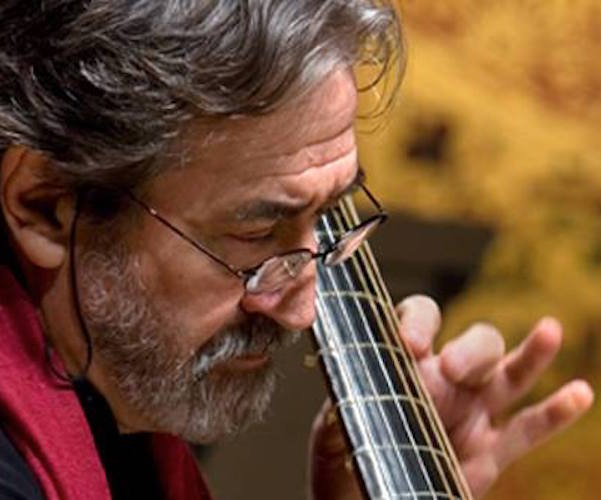Concert Review: Jordi Savall — Giant of the Early Music World
The extremely prolific viol virtuoso Jordi Savall clearly has deep feelings about Celtic music.

Catalan viol player Jordi Savall in action. Photo: courtesy of the artist.
By Susan Miron
Eight hundred admirers packed Cambridge’s St. Paul Church on Saturday night to hear the renowned Catalan viol player Jordi Savall, a rock star of the early music world. For this concert, sponsored by Boston Early Music Festival, Savall brought along his superb colleague Frank McGuire, a virtuoso on the bodhrán, the traditional Irish frame drum. The evening’s program, entitled “Musical Humors and Landscapes in the English, Irish, Scottish, and American Traditions,” is an outgrowth of Savall’s love for Celtic music, which began in the 1970s during a tour with his ensemble in Ireland and resulted a few years ago in two lovely CDs, The Celtic Viol.
The extremely prolific viol virtuoso has recorded over 230 albums covering the Medieval, Renaissance, Baroque, and Classical music repertoires, with a special focus on the Hispanic and Mediterranean musical heritage. But he clearly has deep feelings about Celtic music. He has talked about that affection in interviews. For example:
I think the personality of the Celtic nations is related to a certain human quality of people who are very proud of their roots and who like to conserve the connections with their ancestors. What happened when these people were faced with poverty and had to emigrate was that music became the only bridge that could still connect them with home… What I learned many years ago, when I started to play Sephardic repertory, is that music can help people survive.
For this concert, Savall played what was traditionally fiddle music on a seven string 1750 treble viol (about the size of a viola) and a six-string (with frets) 1697 bass viol (cello-sized) that he held between his knees. He wore what seemed to be his usual attire — a black tunic with a red scarf, while McGuire was dressed in full Scottish highland dress, including a black kilt and matching shirt, with a large silver sporran (the pouch that sits in front of the kilt), and one large glittering earring. Their thirty-plus selections came largely from orally-transmitted music. These Airs, Pastorals, Laments, Hornpipes, Reels, Rants, and Jigs, Savall writes in his program notes, “are true musical survivors, music which has had the privilege and the good luck to survive the inevitable and constant cultural amnesia, as well as the globalizing folly of humanity.” There were also works by several sixteenth and seventeenth century composers, including the famed Turlough O’Carolan (1670-1738).

Frank McGuire, a virtuoso on the bodhrán, the traditional Irish frame drum. Photo: courtesy of the BEMF.
Seven sets of short pieces spanning three centuries were arranged according to tuning and by matching key. In between, there were many retunings on the bass viola, one of which Savall explained was “the bagpipes tuning” which allowed for drone effects. Much like the Celtic harp (an instrument I play) the performer is pretty much stuck in a key; modulations, as well as attempting ambitious dynamics, are difficult to maneuver. Thus, especially in the many slow selections, Savall’s commanding artistry kept the selections from becoming, well, tiring, especially given that most of the pieces are festooned with repetitions.
The music was organized into seven suites (arranged by Savall) derived from Celtic pieces extracted from collections spanning three centuries. The performers alternated slow pieces, which were played by Savall, with faster ones in which McGuire added excitement and interest by joining in on the bodhrán. In truth, I was completely entranced by this instrument, which, for me, all but stole the show.
While the music was beautifully played, there were problems that should be pointed out. The pre-concert “lecture” was poorly organized, and Laury Gutiérrez seemed ill-prepared to serve as emcee. I have heard Savall in Rockport and in Jordan Hall, both halls far better suited for a viol recital than St. Paul’s Church, which supplies superior accommodation for vocal recitals from groups such as the Tallis Scholars. There were many audible complaints from listeners — including those sitting not only on the sides but as close as Row F — who could not see the performers. A platform for the musicians (and a little more heat to warm up this vast church) would have helped considerably. BEMF: Do reconsider using Jordan Hall for this precious artist, so dear to so many of us Boston fans, who will go to hear Savall anywhere, any time.
Susan Miron, a harpist, has been a book reviewer for over 20 years for a large variety of literary publications and newspapers. Her fields of expertise were East and Central European, Irish, and Israeli literature. Susan covers classical music for The Arts Fuse and The Boston Musical Intelligencer. She is part of the Celtic harp and storytelling duo A Bard’s Feast with renowned storyteller Norah Dooley and, until recently, played the Celtic harp at the Cancer Center at Newton Wellesley Hospital.
Tagged: bodhrán, Boston Early Music Festival, Celtic music, Frank McGuire, Jordi Savall
